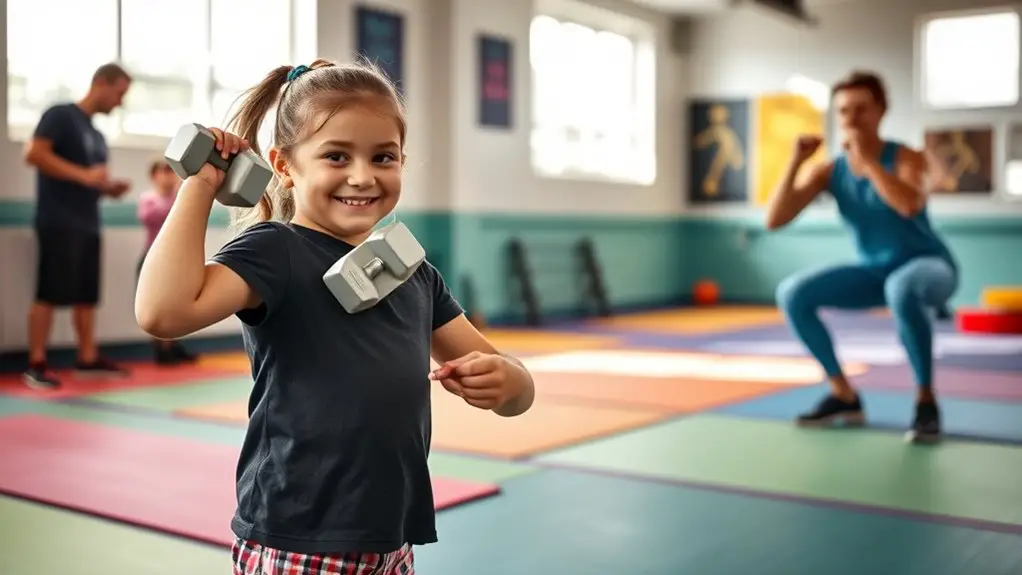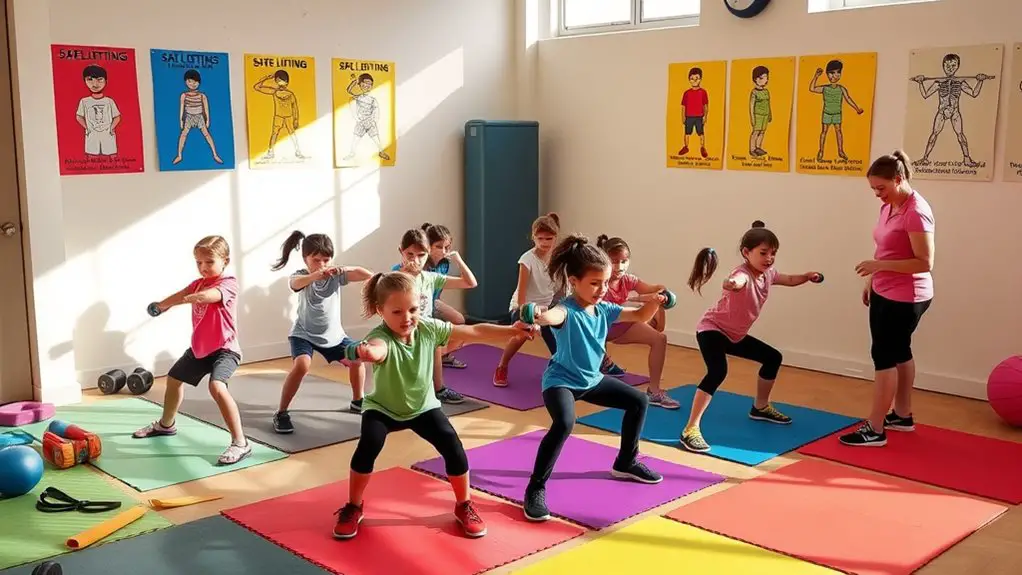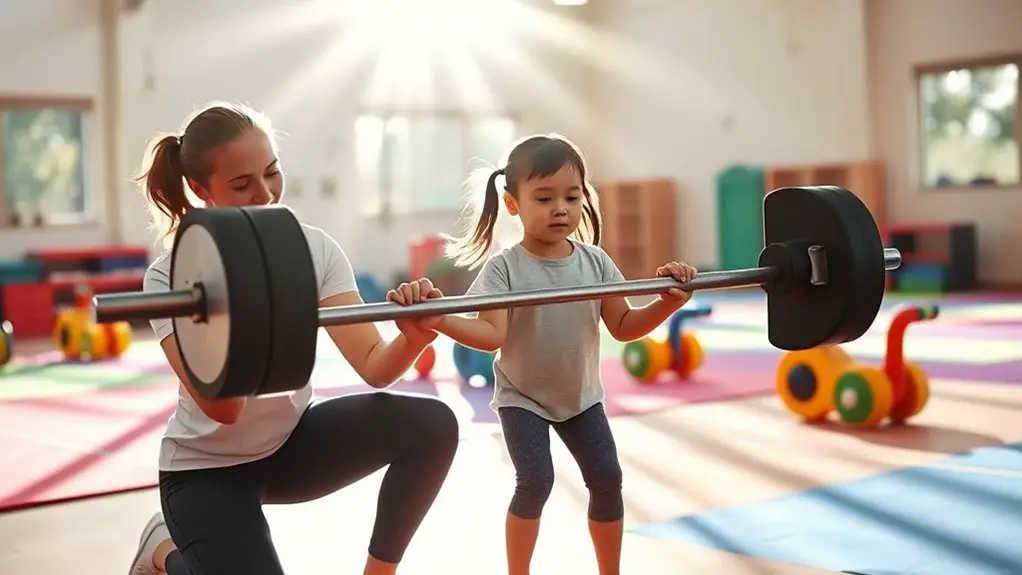How to Introduce Kids to Strength Training Safely

To introduce kids to strength training safely, start by evaluating their readiness, focusing on interest and physical maturity. Choose age-appropriate exercises and emphasize proper techniques to prevent injuries. Establish a safe environment with supervision, suitable equipment, and clear routines. Keep sessions enjoyable to foster a positive attitude towards fitness. Monitor progress, making necessary adjustments to maintain engagement. There’s plenty more to discover about setting your child up for a successful and safe strength training journey.
Understanding the Benefits of Strength Training for Kids

Strength training offers a wealth of benefits for kids, making it a valuable addition to their physical activity routine. A benefits overview shows that engaging in age-appropriate strength training can improve your child’s overall health, boost confidence, and enhance athletic performance. By focusing on strength advantages, your child can build stronger bones and muscles, which helps reduce the risk of injuries in sports and daily activities.
Additionally, strength training supports better posture and coordination, leading to improved balance as they grow. It fosters discipline and a positive mindset, encouraging a lifelong commitment to fitness. Importantly, when you introduce strength training, guarantee it’s done safely and with proper techniques. Start with bodyweight exercises or light resistance, and always supervise them. By prioritizing safety and gradually increasing intensity, you create a fun and effective training experience that sets your child up for success in their physical development.
Assessing Your Child’s Readiness for Strength Training
Before introducing your child to strength training, it’s important to evaluate their readiness. Start by gauging your child’s interest in strength exercises. If they show enthusiasm, it’s a good sign, but it’s equally crucial to take into account their physical maturity. Each child develops at their own pace, so look for signs of readiness, like adequate coordination and the ability to follow instructions.
Also, make sure they can perform basic movements like squats or push-ups correctly before adding resistance. This helps prevent injuries and builds a solid foundation.
Consult with a pediatrician or a certified trainer who specializes in youth fitness to assess their readiness more thoroughly. Remember, safety should always come first. By evaluating both their interest and physical maturity, you can create a positive environment that encourages your child to embrace strength training safely and effectively.
Choosing Age-Appropriate Exercises

When you’re choosing exercises for kids, it’s essential to assess their developmental readiness. Start with body weight movements that promote strength without overwhelming them, and don’t forget to make it fun! Incorporating enjoyable activities can help keep them engaged and excited about their fitness journey.
Assessing Developmental Readiness
As kids grow, their bodies and abilities change, making it vital to assess their developmental readiness for strength training. Start by observing their developmental stages; younger children may not have the physical readiness for complex movements. Focus on their ability to follow instructions, maintain balance, and control their bodies. At ages 6 to 8, simple exercises using body weight can be introduced, allowing them to build a foundation. By ages 9 to 12, they may begin incorporating light weights, but it’s important to prioritize proper form over the amount of weight lifted. Always verify that exercises match their skill level and physical maturity. Remember, safety should always come first in strength training for kids.
Focus on Body Weight
While it’s tempting to jump straight into weights, focusing on body weight exercises is a great starting point for kids. These exercises help build strength, coordination, and balance without the risk of injury that can come from heavy lifting. Simple movements like push-ups, squats, and lunges can be both effective and safe. You can even turn these body weight exercises into fun fitness games, encouraging kids to stay engaged while they learn proper form. Tailor the exercises to their age and skill level to guarantee they’re appropriate and enjoyable. Remember, the goal is to foster a positive attitude toward fitness, so keep things light-hearted and fun. This solid foundation sets the stage for future strength training as they grow.
Incorporating Fun Activities
Building on the foundation of body weight exercises, incorporating fun activities can make strength training even more appealing for kids. You can include fun games and playful challenges that keep them engaged while safely promoting strength. Here’s a table of age-appropriate exercises:
| Age Group | Fun Game | Playful Challenge |
|---|---|---|
| 5-7 years | Animal Movements | Obstacle Course |
| 8-10 years | Balloon Balance | Team Relay Races |
| 11-13 years | Yoga Poses Contest | Strength Circuits |
| 14-16 years | Dance Fitness | Partner Resistance |
| 17+ years | Sports Drills | Circuit Training |
These activities not only build strength but also foster teamwork and enjoyment, ensuring kids develop a positive relationship with fitness.
Teaching Proper Techniques and Form

When teaching kids strength training, emphasizing proper form is vital to prevent injuries and guarantee effective workouts. You’ll want to demonstrate techniques clearly, giving them a visual reference to follow. Remember, progression should be gradual, allowing them to build strength and confidence over time.
Importance of Proper Form
Understanding the importance of proper form is essential for kids as they start their journey into strength training. Emphasizing correct posture not only boosts performance but also plays an important role in injury prevention. Here are three key points to keep in mind:
- Alignment: Verify the spine is straight and the shoulders are back to maintain a neutral position during exercises.
- Movement Control: Teach kids to perform each move slowly and deliberately, avoiding jerky motions that can lead to accidents.
- Breathing: Instruct them to exhale during exertion and inhale during relaxation, which helps with stability and focus.
Demonstrating Techniques Effectively
To guarantee kids grasp proper techniques and form, it is crucial to demonstrate exercises clearly and effectively. Use demonstration techniques that highlight the key movements, ensuring they can see how each exercise is performed. Break down complex movements into simple steps, and encourage kids to watch closely. Provide visual cues, like hand placements and body alignment, to reinforce what they should be doing. Remember to model the exercise yourself, showcasing correct posture and form. It’s also helpful to use props or mirrors, as these can enhance their understanding. Finally, give constructive feedback while they practice, correcting any mistakes gently. This approach not only promotes safety but also builds their confidence in strength training.
Gradual Progression Principles
As kids start their strength training journey, it’s essential to incorporate gradual progression principles to guarantee they master proper techniques and form. This approach helps prevent injuries while building confidence. Here are three key strategies to keep in mind:
- Start light: Begin with minimal weights or resistance to focus on technique before adding more weight.
- Implement gradual increases: Once they’re comfortable, increase weights in small increments, ensuring they can maintain proper form.
- Introduce incremental challenges: As their skills improve, vary exercises to keep them engaged and challenged without overwhelming them.
Establishing a Safe Training Environment
While introducing kids to strength training can be exciting, ensuring a safe training environment is essential for their well-being. First, choose a dedicated training area with enough space for movement and no obstacles. This will help prevent accidents and allow kids to focus on their exercises.
Next, invest in appropriate safety equipment, such as mats, weightlifting belts, and proper footwear, to minimize the risk of injury. Always supervise your kids during workouts, especially when they’re using weights or performing unfamiliar movements.
Instruct them on using equipment correctly and emphasize the importance of proper warm-up and cool-down routines. Regularly inspect the training area and equipment for any wear and tear, replacing items as needed. By prioritizing safety, you’ll create a supportive environment that encourages kids to enjoy strength training while minimizing risks.
Encouraging a Positive Attitude Towards Fitness
Fostering a positive attitude toward fitness starts with making it fun and engaging for kids. By creating a supportive environment, you can help them develop a strong fitness mindset. Here are three effective strategies:
Fostering a love for fitness in kids begins with fun and support, cultivating a positive mindset toward healthy habits.
- Make it Playful: Incorporate games and activities that promote movement while keeping it light-hearted. This way, kids associate fitness with fun rather than a chore.
- Set Achievable Goals: Help them set realistic and attainable fitness goals. When they reach these milestones, celebrate their achievements to reinforce their efforts with positive reinforcement.
- Be a Role Model: Show your enthusiasm for fitness by participating alongside them. Your positive attitude will inspire them to adopt healthy habits.
Monitoring Progress and Making Adjustments
To guarantee kids stay engaged and make progress in their strength training journey, it’s essential to regularly monitor their development and adjust their routines as needed. Progress tracking helps you recognize improvements and identify areas where adjustments may be beneficial.
Here’s a simple table to guide you in making effective adjustments:
| Observation | Adjustment Strategy | Notes |
|---|---|---|
| Lifting too easily | Increase weight slightly | Focus on form first |
| Struggling with reps | Reduce weight or reps | Maintain proper technique |
| Loss of interest | Change exercise variety | Keep workouts fun |
| Plateau in progress | Add new challenges | Incorporate different moves |
| Fatigue or soreness | Extend rest periods | Prioritize recovery |
Frequently Asked Questions
What Equipment Is Safe for Kids to Use During Strength Training?
Choosing equipment for kids is like picking the right shoes for a race; it’s all about comfort and safety. Bodyweight exercises are fantastic since they rely on your child’s own strength, making them safe and effective. Resistance bands are another great option, offering adjustable resistance without the risk of injury. Always supervise your kids during workouts, ensuring they use proper form and techniques to keep their training experience both fun and safe.
How Often Should Kids Train Each Week?
When considering strength training frequency for kids, it’s important to balance safety with effectiveness. Generally, kids aged 6-12 can train 2-3 times a week, while teens might increase to 3-4 times, depending on their maturity and fitness level. Always focus on proper form and lighter weights to prevent injury. Listen to their bodies and make sure they’re not overtraining. Incorporating rest days is essential for recovery and growth, so keep that in mind!
Can Strength Training Stunt a Child’s Growth?
Think of a young tree, its growth determined by both the soil and the care it receives. When you ask if strength training can stunt a child’s growth, remember that improper technique might harm their growth plates, but with the right approach, it’s safe and beneficial. If you encourage proper technique and monitor their training, you’re nurturing their development rather than hindering it. So, focus on safety and watch them flourish like that sturdy tree.
What Should Kids Do if They Feel Pain While Training?
If you feel pain while training, it’s vital to listen to your body. Stop the activity immediately and assess the pain. It’s essential for injury prevention to avoid pushing through discomfort. Consider using basic pain management techniques, like rest or applying ice. If the pain persists, consult a healthcare professional. Remember, safety comes first, and it’s always better to be cautious than to risk a more serious injury.
How Can Parents Encourage Consistency in Their Child’s Training Routine?
Think of consistency as planting a seed; with proper care and nurturing, it’ll flourish. You can encourage your child’s training routine by setting achievable goals together, allowing them to see progress. Celebrate their efforts with positive reinforcement—praise their dedication and achievements, no matter how small. This creates a supportive environment, making them more likely to stick with it. Remember, it’s about building habits that last, not just short-term gains.





